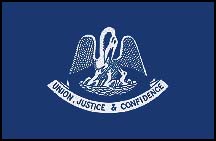When I was going to grammar school in Metairie in the early 1970s, I learned that the state bird of Louisiana was the brown pelican. When I became an Eagle Scout in the 1980s, our state senator got me named an honorary colonel in the Louisiana National Guard and our state representative presented me with a Louisiana state flag. (Among other things, this lost my respect for our state legislature, since they seemed to have nothing better to do with their time than attend Boy Scout Court of Honors to hand out flags and honorary commissions.)

The Louisiana state flag shows a pelican feeding its three young. The myth, enshrined on the flag, was that the pelican fed its young on its own blood, and if you look closely at a high quality Louisiana flag you can see the drops of blood the mother pelican has pulled out of her breast to feed her chicks. This part of the story happens to be a myth. Pelicans feed their young partially digested, regurgitated fish, just like many other bird species do. However at the time, the pelican's very existence seemed about as mythical as the story of it feeding its children on its own blood. In fact, the flag could have featured a unicorn or a sea serpent, and it would have seemed equally real.
You see, when I was growing up in Louisiana you heard about pelicans, you saw them on the state flag, you saw pictures of them in books; but you never, ever actually saw a real live brown pelican, not even in the Audubon Zoo and certainly not in the wild. They were even less real to me than the bald eagle which, while not common in Louisiana, I had seen at least a few examples of in various zoos.
The fundamental problem were pesticides, specifically DDT, endrin and dieldrin. Pelicans eat fish. Fish eat smaller animals. The smaller animals absorb these pesticides (especially DDT) into their bodies. Pesticides are poison, and at every step along the food chain they get more and more concentrated in the body of the animal. The animal at the top of the food chain, the brown pelican in this case, is, after a lifetime of eating Louisiana's toxic fish, positively packed with poison. The specific effect of this poison on the brown pelican and many other birds is that their egg shells become brittle; so brittle, in fact, that they tend to break when the mother pelican sits on them. The pelicans become unable to raise young, and their population plummets.
Pesticides aren't the only factor that led to the pelicans' decline. In the late 19th and early 20th centuries, people hunted pelicans for their feathers, mostly for womens' hats. Following that, fishermen who mistakenly believed that pelicans were competing with them for fish slaughtered any they could catch. (In fact, pelicans mostly eat fish that commercial fishermen ignore.) Widespread damage to the Louisiana environment didn't help them either. Chemical companies routinely dump huge amounts of other chemicals into the Mississippi and other Louisiana waterways. Oil companies introduce extra salt water into the heart of Louisiana swamps by cutting straight paths for barges through places where only meandering bayous used to flow. Dredging for shells in Lake Pontchatrain and other lakes destroyed the ecosystem there, and the list goes on. Even when one of these problems didn't hurt the pelicans directly, it often drastically reduced their food supply. But pesticides were certainly the most proximate cause of the brown pelicans' near extinction in Louisiana. Once endrin was introduced into Lousiana in 1952 to control the boll weevil, bollworm, and sugar cane borer the pelican population plumeeted from tens of thousands to almost none within the space of a decade.
DDT was banned in the United States in 1972 (though it's still used in Mexico and many other countries in the pelican's range) and endrin wasn't much used in Lousiana after 1976. (It's now banned completely.) However, by that point the brown pelican was firmly on the endangered species list. There weren't more than a few thousand world wide at that point and exactly none in Lousisiana. And this is why the pelican seemed like something of a mythical bird to me growing up. But I'm pleased to report it's a myth no longer.